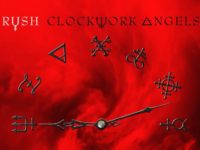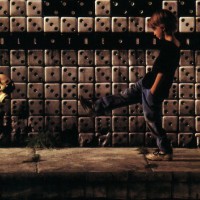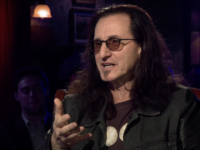As sad as classic album-rockers like Rush are to see long-form recordings lose momentum in the marketplace, the new single-song market has its advantages, guitarist Alex Lifeson says: It keeps fans engaged.
The band’s ambitious story-cycle Clockwork Angels, Rush’s first new studio project since 2007’s Snakes and Arrows, is in many ways a throwback to the 1970s’ staple of concept albums. It arrived, however, in a time much different than when Rush was issuing recordings with extended narratives like 2112.
Digital music sales, primarily singles, were up eight percent in 2011, while the rest of the industry sags badly. Just this week, Rihanna topped the UK album charts after selling fewer than 10,000 copies — a new low since modern statistical records have been kept. Album sales fell an average of 8 percent each year during the 2000s, and those numbers have continued a steep decline into the new decade. By 2016, sales at record stories could drop as much as another 77 percent, according to a Wall Street Journal report.
[SOMETHING ELSE! REWIND: Our first-take talk around the watercooler at SER Towers on “Headlong Flight,” the 2012 single from Rush’s album ‘Clockwork Angels,’ sparked a spirited debate.]
“You have to get over it; it’s just the way it is now,” Lifeson told Music and Musicians Magazine. “We grew up with albums, and for us the album was always the thing — we’ve never been a singles band. We’ve released singles, sure, and we’ve had some moderate success with some, but we’ve never been that kind of band. So yes, I’m sorry to see the album and everything it represented go.”
As much as Lifeson and Co. have always been focused on the multi-song concept when recording, however, Rush did release advance stand-alone singles this time: “Caravan” and “BU2B” were issued before Rush resumed touring in 2010, something that kept fans’ interest spiked for the eventual album.
That’s something that the band likely will do again, Lifeson says, as inspiration strikes.
“It was like a book, and now you’re buying chapters that don’t always relate to the whole book. That said, it was fun to release a couple of songs beforehand as a bit of a teaser,” he told Music and Musicians. “It got us thinking that in the future we might record two or three songs and release them every six months. But for now, especially with a project this size, an album was the only way to go.”
[amazon_enhanced asin=”B007I2BZIE” container=”” container_class=”” price=”All” background_color=”FFFFFF” link_color=”000000″ text_color=”0000FF” /] [amazon_enhanced asin=”B005D0RDIE” container=”” container_class=”” price=”All” background_color=”FFFFFF” link_color=”000000″ text_color=”0000FF” /] [amazon_enhanced asin=”B000C4BBZ2″ price=”All” background_color=”FFFFFF” link_color=”000000″ text_color=”0000FF” /] [amazon_enhanced asin=”B00569507I” /] [amazon_enhanced asin=”B000W1YYSQ” price=”All” background_color=”FFFFFF” link_color=”000000″ text_color=”0000FF” /]
Here’s a look back at our previous thoughts on Rush. Click through the titles for complete reviews …
RUSH – CLOCKWORK ANGELS (2012): Time after time, I find myself reaching to re-cue this album when the last notes fade. What is it that brings me back? Most simplistically, it’s hearing Rush sound so vital and vibrant. Rush has typically done what it wanted to do, but just like you can sense a smile on the face of someone on the other end of the telephone line, music listeners can sense that same smile, maybe in the form of enthusiasm, in the playing. A little extra finesse here and there from Neil Peart’s expert drumming, a little something extra wild in Alex Lifeson’s guitar solo, or the flair of a grace note or two in Geddy Lee’s bassline. The band always at the top of their game — that’s what Rush is known for — but sometimes they play at the very top of the top, as here.
RUSH – TIME MACHINE 2011: LIVE IN CLEVELAND (2011): Rush used this opportunity to, as they really have been doing each tour lately, rifle through catalog and pull out some dusty old gems (“Time Stand Still,” reggae “Working Man,” “Marathon,” “Subdivisions,” “Stick It Out” and “Leave That Thing Alone”) and even one bonafide “never been played before” fan favorite (“Presto”) but, most importantly, a run-through of their entire classic Moving Pictures album for its 30th anniversary. Some of those tunes have been played a lot (“Tom Sawyer,” “Limelight,” I’m looking at you) but others have disappeared for far, far too long. Welcome back to the stage “The Camera Eye” and “Witch Hunt.” Maybe you’ll stick around for a couple tours?
SOMETHING ELSE! FEATURED ARTIST: RUSH: When most think of Rush, it’s their instrumental virtuosity (especially drummer Neil Peart) that comes to mind first. Or the love or hatred of Geddy Lee’s vocals. Other times it’s Peart’s second role as lyricist for the band that garners attention, and it’s another love or hate area of focus: Ayn Rand, sci-fi, songs about balding, fights between dogs and, well, whatever a Bytor is, these are all common targets for those who want to throw stones. We’re here to present an argument for the defense.
RUSH – ROLL THE BONES (1991; 2011 reissue): Listeners will hear immediately that the sound is indeed lighter and quieter, and the soundstage is thinner than either previous version. But it’s all to better show off the album’s immaculate recording, which does get a bit muffled in the Atlantic pressings. This is where you can revel in the tone of Geddy’s maturing voice, or the textures of Alex Lifeson’s guitar, or the layers of keyboard washes that are now magically so much more discernible from one another. With regard to those keyboard washes, what’s funny is that once you hear them here, you can’t help but notice them in the other versions, too. It just took this delicate audiophile edition to separate them out.
- Ernesto Cervini’s Turboprop, “When I Fall” (2024): Video premiere - March 15, 2024
- Disaster Pony,“Dead Neon & The Noon Sun” from ‘Disaster Pony’ (2024): Video premiere - February 27, 2024
- Christopher Hoffman, “Farewell Forever” from ‘Vision Is The Identity’ (2024): Streaming premiere - February 19, 2024




